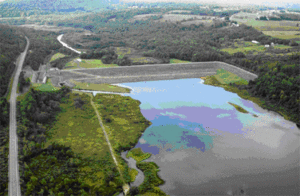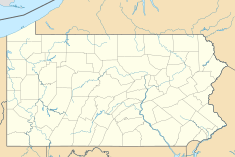Stillwater Dam (Pennsylvania) facts for kids
Quick facts for kids Stillwater Dam |
|
|---|---|

Stillwater Dam and lake
|
|
|
Location of Stillwater Dam in Pennsylvania
|
|
| Country | USA |
| Location | Clifford Township, Susquehanna County, near Union Dale, Pennsylvania, USA |
| Coordinates | 41°41′48″N 075°29′09″W / 41.69667°N 75.48583°W |
| Purpose | Flood control |
| Opening date | September 1960 |
| Construction cost | $5,725,700 |
| Dam and spillways | |
| Impounds | Lackawanna River |
| Height (thalweg) | 75 ft (23 m) |
| Length | 1,700 ft (518 m) |
| Reservoir | |
| Inactive capacity | 11,600 acre⋅ft (14,308,389 m3) |
| Catchment area | 36.8 sq mi (95 km2) |
The Stillwater Dam is a special kind of wall built across the Lackawanna River in Susquehanna County, Pennsylvania. It helps protect nearby towns from floods. This dam was finished in September 1960.
Contents
Stillwater Dam: Protecting from Floods
The Stillwater Dam is an important structure in Pennsylvania. It is located about 3.2 mi (5 km) north of Forest City. Its main job is to control floods.
What is an Embankment Dam?
The Stillwater Dam is an embankment dam. This means it is built using natural materials like earth and rock. These materials are carefully packed together to form a strong barrier. This type of dam is very common for flood control.
Why Was Stillwater Dam Built?
The main reason the Stillwater Dam was built was for flood control. Rivers can sometimes overflow their banks, especially after heavy rain or snowmelt. This can cause a lot of damage to homes and businesses. The dam helps to stop this from happening.
How Does It Prevent Floods?
The dam works by holding back extra water when the river gets too full. It creates a reservoir, which is like a large lake. Most of the time, this reservoir is kept at a low level. This leaves plenty of space to store floodwaters if needed.
When there's a lot of rain, the dam holds back the extra water. This stops the river from flooding downstream. Once the danger has passed, the water is slowly released. This helps keep communities safe.
When Was the Dam Most Full?
The highest the water ever got in the reservoir was on April 2, 1993. On that day, the water level reached 1,617.85 ft (493 m). This meant the reservoir was nearly 89% full. It shows how much water the dam can hold during a flood event.


